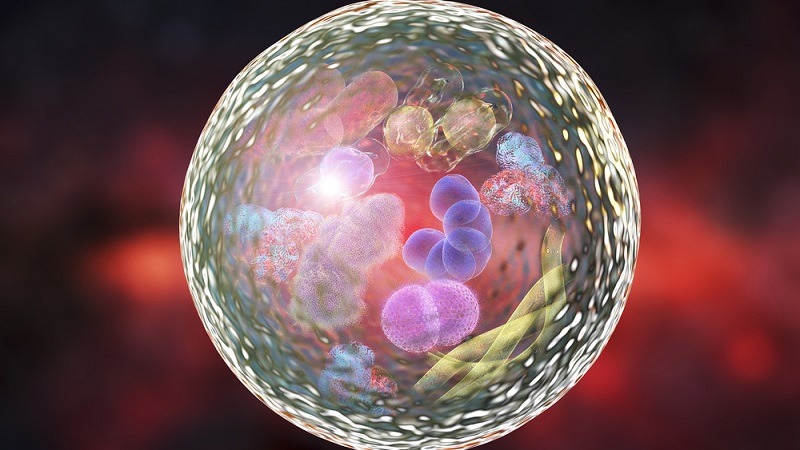What is Spermidine? A Summary of Spermidine
 Steve H
06 Aug 2021
Steve H
06 Aug 2021
Found in grapefruit, spermidine is one of the more interesting polyamines, and some research suggests that spermidine and its derivatives may be able to slow down aging and promote longevity.
What is spermidine?
Spermidine is a naturally occurring polyamine, having two or more primary amino groups, and it is widely encountered in ribosomes and living tissues. It plays a critical role in cell function and survival.
One of the pioneers of microscopy, Dutch scientist Anton Van Leeuwenhoek, first discovered spermine in a sample of human semen in 1678; likewise, spermidine was also initially identified in human sperm. In the body, spermidine is created from its precursor putrescine. Like many molecules, spermidine is also the precursor for additional polyamines, spermine being a primary example that is also important for cellular function.
Polyamines such as spermidine and putrescine are known to promote autophagy, which plays an important role in the degradation of waste and the recycling of cellular components. Autophagy is an important quality control mechanism for the mitochondria, the powerhouses of our cells, and it allows damaged or defective mitochondria to be broken down and disposed of. The degradation of mitochondria through the mechanism of autophagy is more tightly controlled than was previously believed [1].
Polyamines are able to bind many different types of molecules, which gives them great utility and allows them to support many processes, including cell growth, DNA stability, cell proliferation, and apoptosis [2]. It also seems to be the case that polyamines function in a similar way to growth factors during cell division. Therefore, it is not hard to understand why putrescine and spermidine are important for healthy tissue growth and function.
What foods are high in spermidine?
A number of dietary sources of spermidine have been discovered, including grapefruit, mature cheese, mushrooms, soy products, legumes, corn, whole grain, chickpeas, peas, green peppers, broccoli, oranges, green tea, and rice bran. It is also worth noting that many of the foods associated with a Mediterranean diet contain significant amounts of spermidine.
Of course, if you struggle to get enough spermidine in your diet, dietary supplement manufacturers have got you covered. Synthetic spermidine is produced as a supplement, and it is identical to the naturally occurring molecule.
What is putrescine?
Before we dive into some of the interesting research behind spermidine and why some researchers think it might be useful in slowing down aging, we should first take a look at how it is created.
There are two pathways in which putrescine is created, though both start with the amino acid arginine.
The first pathway sees arginine converted into agmatine with support from an enzyme known as arginine decarboxylase. In the next step, the agmatine gets converted into N-carbamoyl putrescine by agmatine imino hydroxylase. Finally, N-carbamoyl putrescine is transformed into putrescine, and the transformation is complete.
The second pathway simply converts arginine into ornithine followed by its conversion into putrescine by the enzyme ornithine decarboxylase.
What is spermidine used for?
Some research suggests that it may prevent liver fibrosis and hepatocellular carcinoma, common causes of liver cancer. Some people take it as a supplement believing it may have an impact on aging and promote longevity. It is most well known for its ability to boost autophagy, a cellular recycling routine that can help cells remove waste and unwanted components, which is also the most likely reason it may influence aging.
Possible benefits of spermidine
There are a number of potential benefits from supplementing with spermidine, and some of them may influence aging and support healthy longevity.
Spermidine and autophagy
As mentioned before, putrescine allows the creation of spermidine as part of a process in which putrescine breaks down decarboxylated S-adenosylmethionine.
It plays an important role in the regulation of various biological processes, including levels of intracellular pH and the maintenance of cell membrane potential. Spermidine also plays a central role in a number of important biological processes, including aspartate receptors, cGMP/PKG pathway activation, nitric oxide synthase, and cerebral cortex synaptosome activity.
Spermidine is of interest to scientists in the context of aging because it is a key morphogenetic determinant for the lifespan of cells and living tissues [3]. The ability of spermidine to trigger autophagy is thought to be the main mechanism by which it appears to slow down aging and support longevity [4].
It has been demonstrated to induce autophagy in mouse liver cells, worms, yeast and flies [5]. A defective autophagy mechanism and a lack of spermidine are highly correlated with reduced life spans, chronic stress, and acute inflammation.
Spermidine anti-inflammatory properties
Although the primary way in which spermidine appears to support longevity is via autophagy, there is also evidence that it supports health and longevity in other ways. Some studies suggest that it has anti-inflammatory properties [6-7] and is involved in lipid metabolism, cell growth and proliferation [8-9], and programmed cell death, which is known as apoptosis [10].
It is widely accepted that while inflammation plays a helpful role in wound healing and repelling invading pathogens, the persistent inflammation associated with aging, often called inflammaging, is harmful. Chronic inflammation prevents healthy tissue regeneration, causes the immune system to become dysfunctional, and can even accelerate the speed at which healthy cells become senescent. Spermidine appears to reduce this chronic inflammation and may slow down one way in which cells and tissues age.
Spermidine and longevity
On the longevity front, the administration of spermidine has been shown to increase lifespan in a number of animal studies and prevents liver fibrosis and hepatocellular carcinoma [11-12]. This also appears to be the case with a diet rich in polyamines [13]. There is also some evidence to suggest that it improves resistance to stress and that the age-related decline of spermidine supports the onset of age-related diseases [14-15].
Lipid metabolism is a known regulator of lifespan, and dysfunctional lipid metabolism can have serious ramifications for both healthspan and lifespan. The role that spermidine plays in the process of adipogenesis, the creation of adipocytes (fat cells) from stem cells, and its ability to modify lipid profiles could suggest another way in which spermidine influences lifespan. Spermidine facilitates the differentiation of preadipocyte cells into mature adipocyte cells as part of the adipogenesis process [16].
A study showed that administration of a-difluoromethylornithine (DFMO), an inhibitor of polyamine synthesis, could halt adipogenesis entirely [17]. This total disruption of lipid metabolism could be reversed by the administration of spermidine despite DFMO still being present. The researchers observed that spermidine also restored the expression of transcription factors needed for preadipocyte differentiation as well as those associated with late adipocyte markers.
If these compounds are taken together, the combination of effective autophagy, reduction of inflammation, lower stress levels in the cell, improved cell growth, and improved lipid metabolism may potentially support healthy longevity.
Spermidine may improve cognitive function
Research published in 2021 in the journal Cell Reports provides a detailed account of dietary spermidine improving cognition and mitochondrial function in flies and mice, with some prospective human data to top it off [18]. While this study was interesting, it had some limitations, and additional dose-response data is needed before a firm conclusion can be made about benefits to human cognition.
Spermidine side effects
There are no known adverse side effects from spermidine supplementation. There have been a number of studies conducted with it, and the results suggest that it is well tolerated. Of course, as with any supplement, if you do experience side effects, cease taking it immediately and consult your doctor.
Disclaimer
This article is only a very brief summary, is not intended as an exhaustive guide, and is based on the interpretation of research data, which is speculative by nature. This article is not a substitute for consulting your physician about which supplements may or may not be right for you. We do not endorse supplement use or any product or supplement vendor, and all discussion here is for scientific interest.
Literature
[1] Goldman, S. J., Taylor, R., Zhang, Y., & Jin, S. (2010). Autophagy and the degradation of mitochondria. Mitochondrion, 10(4), 309-315.
[2] Minois, N., Carmona-Gutierrez, D., & Madeo, F. (2011). Polyamines in aging and disease. Aging (Albany NY), 3(8), 716-732.
[3] Deeb, F., van der Weele, C. M., & Wolniak, S. M. (2010). Spermidine is a morphogenetic determinant for cell fate specification in the male gametophyte of the water fern Marsilea vestita. The Plant Cell, 22(11), 3678-3691.
[4] Eisenberg, T., Knauer, H., Schauer, A., Büttner, S., Ruckenstuhl, C., Carmona-Gutierrez, D., … & Fussi, H. (2009). Induction of autophagy by spermidine promotes longevity. Nature cell biology, 11(11), 1305-1314.
[5] Eisenberg, T., Knauer, H., Schauer, A., Büttner, S., Ruckenstuhl, C., Carmona-Gutierrez, D., … & Fussi, H. (2009). Induction of autophagy by spermidine promotes longevity. Nature cell biology, 11(11), 1305-1314.
[6] Bjelakovic, G., Stojanovic, I., Stoimenov, T. J., Pavlovic, D., Kocic, G., Rossi, S., … & Bjelakovic, L. J. (2010). Metabolic correlations of glucocorticoids and polyamines in inflammation and apoptosis. Amino acids, 39(1), 29-43.
[7] Choi, Y. H., & Park, H. Y. (2012). Anti-inflammatory effects of spermidine in lipopolysaccharide-stimulated BV2 microglial cells. Journal of biomedical science, 19(1), 31.
[8] Landau, G., Ran, A., Bercovich, Z., Feldmesser, E., Horn-Saban, S., Korkotian, E., … & Kahana, C. (2012). Expression profiling and biochemical analysis suggest stress response as a potential mechanism inhibiting proliferation of polyamine-depleted cells. Journal of Biological Chemistry, 287(43), 35825-35837.
[9] Landau, G., Bercovich, Z., Park, M. H., & Kahana, C. (2010). The role of polyamines in supporting growth of mammalian cells is mediated through their requirement for translation initiation and elongation. Journal of Biological Chemistry, 285(17), 12474-12481.
[10] Minois, N., Carmona-Gutierrez, D., & Madeo, F. (2011). Polyamines in aging and disease. Aging (Albany NY), 3(8), 716-732.
[11] Yue, F., Li, W., Zou, J., Jiang, X., Xu, G., Huang, H., & Liu, L. (2017). Spermidine prolongs lifespan and prevents liver fibrosis and hepatocellular carcinoma by activating MAP1S-mediated autophagy. Cancer Research, canres-3462.
[12] Eisenberg, T., Abdellatif, M., Schroeder, S., Primessnig, U., Stekovic, S., Pendl, T., … & Tong, M. (2016). Cardioprotection and lifespan extension by the natural polyamine spermidine. Nature medicine.
[13] Soda, K., Dobashi, Y., Kano, Y., Tsujinaka, S., & Konishi, F. (2009). Polyamine-rich food decreases age-associated pathology and mortality in aged mice. Experimental gerontology, 44(11), 727-732.
[14] Minois, N., Carmona-Gutierrez, D., Bauer, M. A., Rockenfeller, P., Eisenberg, T., Brandhorst, S., … & Madeo, F. (2012). Spermidine promotes stress resistance in Drosophila melanogaster through autophagy-dependent and-independent pathways. Cell death & disease, 3(10), e401.
[15] Landau, G., Ran, A., Bercovich, Z., Feldmesser, E., Horn-Saban, S., Korkotian, E., … & Kahana, C. (2012). Expression profiling and biochemical analysis suggest stress response as a potential mechanism inhibiting proliferation of polyamine-depleted cells. Journal of Biological Chemistry, 287(43), 35825-35837.
[16] Vuohelainen, S., Pirinen, E., Cerrada-Gimenez, M., Keinänen, T. A., Uimari, A., Pietilä, M., … & Alhonen, L. (2010). Spermidine is indispensable in differentiation of 3T3-L1 fibroblasts to adipocytes. Journal of cellular and molecular medicine, 14(6b), 1683-1692.
[17] Hyvönen, M. T., Koponen, T., Weisell, J., Pietilä, M., Khomutov, A. R., Vepsäläinen, J., … & Keinänen, T. A. (2013). Spermidine promotes adipogenesis of 3T3-L1 cells by preventing interaction of ANP32 with HuR and PP2A. Biochemical Journal, 453(3), 467-474.
[18] Schroeder, S., Hofer, S.J., Zimmermann, A., Pechlaner, R., Dammbrueck, C., … & Madeo, F. (2021). Dietary spermidine improves cognitive function. Cell Reports, 35(2), 108985. https://doi.org/10.1...rep.2021.108985
The post What is Spermidine? A Summary of Spermidine first appeared on Lifespan.io.
View the article at lifespan.io








